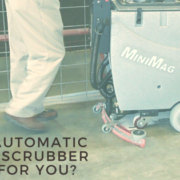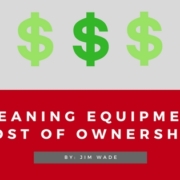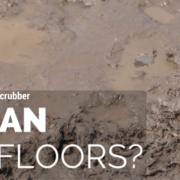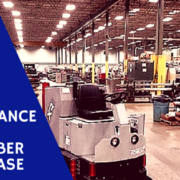Why Won’t My Automatic Scrubber Pick Up Water?
This is part 3 of a 5 part series on common automatic floor scrubber problems. To recap, the first part is an overview of all the problems discussed and the second part is focused why your scrubber isn’t putting water down and if you’re reading this then you probably are either having issue with your scrubber not picking up water or are interested in learning some of the potential reasons for a scrubber leaving water behind.
Vacuuming up the dirty water on an automatic scrubber hasn’t changed a whole lot since the machines were first developed.  It is basically a vacuum motor pulling air and water through a hose attached to a squeegee on the rear of the scrubber.  The vacuum motor may be a 12, 24 or 36 volt motor, and it may be found in different places in the machine depending on the make and model, but the principle is the same. Some squeegees are lowered by hand and some lower automatically when the machine moves forward with the water control turned on.  Some vacuum motors are turned on with a switch and others turn on automatically when the squeegee is lowered.  Assuming that the vacuum motor is operating and the squeegee mechanism is down, let’s take a look at why you may not be picking up the dirty water.
- Check to see if the vacuum pickup hose is attached.  It is not uncommon to find a hose that is not completely attached to the squeegee assembly.  This disrupts the airflow and the water doesn’t get sucked up.
- Check the vacuum hose for holes or air leaks. Â Breaks in the hose allow for lost suction and bad water pickup.
- Make sure the vacuum hose is attached to the recovery water tank at the other end. Â Once again checking for air leaks.
- Make sure the vacuum motor is attached in some fashion to the recovery tank.  This can be a direct connection or through a hose.   An air leak here and you won’t create a vacuum in the recovery water tank.
- The squeegee assembly should be completely level. Â If an operator hit something with the assembly, it may have bent the bracket causing the squeegee to become out of line. Â This can create gaps between the squeegee and the floor surface leaving large streaks of water on the floor.
- Squeegees wear over time. Â Worn or torn squeegees do not pick up water well. Â Most squeegees can be removed and turned over to use the other side but eventually they all need to be replaced. Â Regular replacement will better insure a clean wipe by the blades.
- Keep the squeegee blades clean. Â Remove the assembly and wash it thoroughly after each use. Â A good habit to have is to wipe off the inside of the blades periodically while using the scrubber. Â This keeps tiny pieces of dirt and grit from accumulating and causing bad streaks.
- Hoses can clog periodically when picking up large pieces of debris or operating on extremely dirty floors. Â Simply run a broom handle down the hose to remove the clog, and then clean out the hose.
- Back flush the vacuum hose after each use. This will help to prevent clogs from occurring and provide maximum suction to the squeegee assembly.
- Clean the debris trays or baskets or deflectors in the recovery water tank after each use. Â Â This increases airflow through the hoses for better suction.
- Clean and check lid gaskets after each use. Â Bad or dirty gaskets can cause air leaks and lost suction.
- Clean the float assembly in the recovery tank and check to see if it is stuck in the closed position. Â This will prevent air flow and water pickup.
Water pickup with your automatic scrubber is essentially an easy concept to understand and maintain. Â If you do not have good water pickup it is most likely because of worn or clogged hoses, worn squeegees or worn gaskets. Â Check for air leaks and obstructions and make sure you have a clean, level wiping surface on your squeegees.
For more information on how you can better maintain your automatic floor scrubber follow our blog and if there is anything else you need help with give us a call or contact us.











